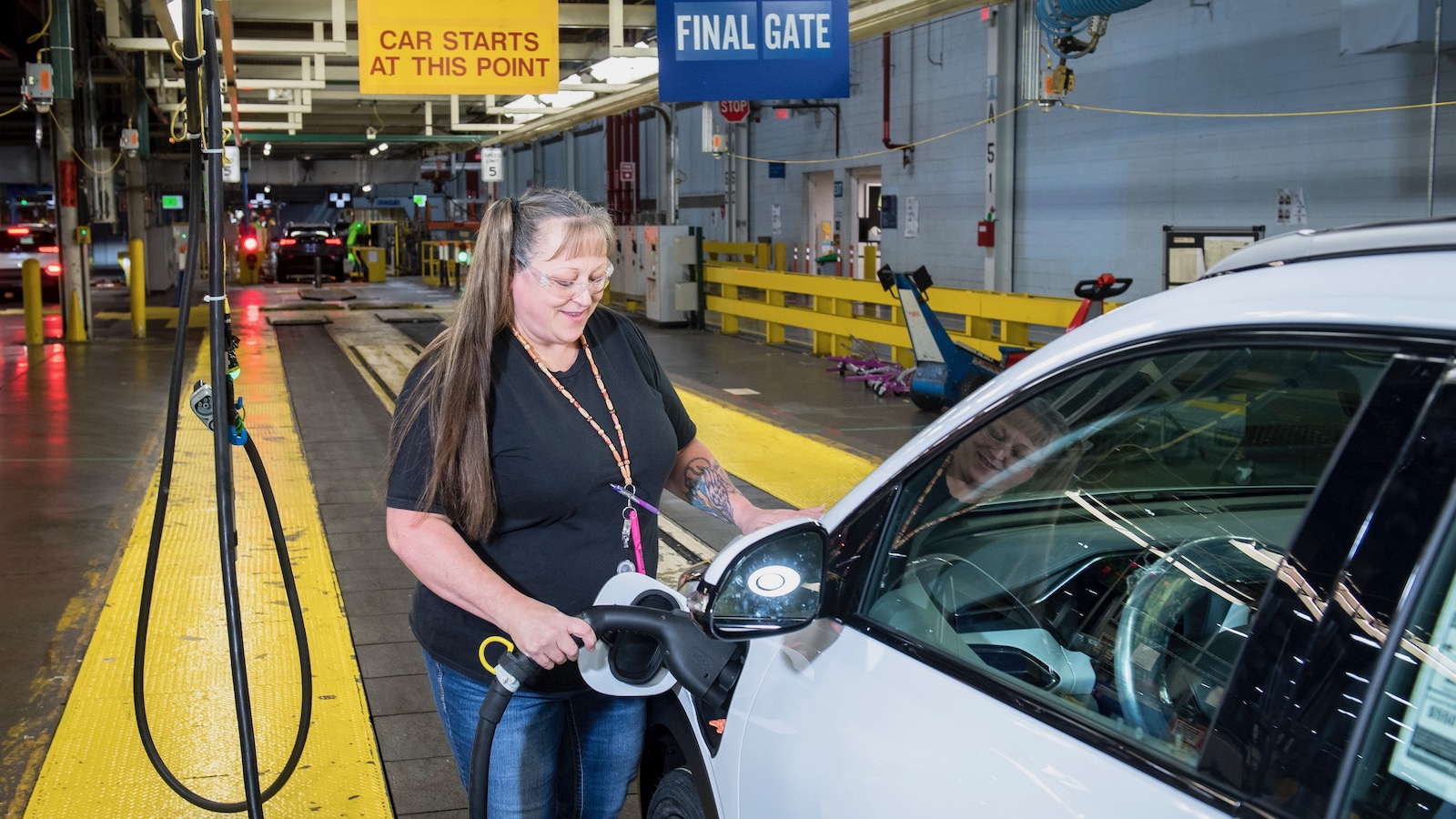United Auto Workers president Shawn Fain wore a T-shirt reading “Eat the Rich” and a deadly serious stare when he announced a major development in the union’s monthlong strike: General Motors agreed to include its electric vehicle and battery factories in the forthcoming labor contract. That deal will cover 6,000 employees at four coming GM battery plants.
“We have been told for months this is impossible,” Fain said during the October 6 livestream. “We have been told the EV future must be a race to the bottom. We called their bluff.”
If Fain has made anything clear, it is that he, and the 383,000 people he leads, are not bluffing. In the two weeks since GM’s concession, the union has redoubled its efforts to win similar agreements from Ford and Stellantis. Last week, every one of the 8,700 workers at Ford’s massive Kentucky Truck Plant in Louisville joined the picket line, halting production of the company’s line of Super Duty pickup trucks.
GM’s promise to unionize its EV and battery operations comes after automakers sold 300,000 EVs in the previous quarter, and everyone involved in the labor dispute feels the electric transition is all but inevitable. The strike has increased pressure on the Big Three to include their electrification ventures in the master contracts they hold with United Auto Workers, or UAW. It also could press other automakers to increase pay or agree to unionize if they hope to compete for workers.
Fain has made negotiating stronger contracts, including cost-of-living adjustments and four-day workweeks, a priority since his election in March. He also has castigated the Big Three’s battery factories for their low wages. When contract negotiations stalled, UAW members went on strike on September 14. There are now 34,000 autoworkers on strike nationwide, a number that is likely to grow as negotiations drag on.
Dianne Feeley is a retired autoworker who, like other UAW retirees, remains an active and voting union member. She says the rank and file spent 40 years working toward this moment, a fight that started as years of stagnation and corruption kept the UAW from moving forward. That led to a band of members launching United All Workers for Democracy, which expanded members’ rights to participate in bargaining and helped propel Fain to into leadership. It’s also helped conversations about the EV transition and its impact on workers come to the fore.
“This [UAW] administration has said, ‘Yes, let’s do electric vehicles, but there has to be a just transition.’ Whereas the old leadership, they didn’t even want to hear about electric vehicles,” Feeley said.
Beyond ensuring that the workers assembling electric vehicles are paid the same as those assembling conventional cars, the risks inherent in battery production are a major concern to union members. Safety issues at GM’s Ultium Cells battery plant in Lordstown, Ohio, led to the factory’s unionization earlier this year. An explosion and fire there in March prompted an investigation by the Occupational Safety and Health Administration. Its inquiry, released last week, found 17 violations, including inadequate respiratory protection equipment, emergency showers, and eye-washing stations. OSHA could levy $270,000 in fines.
“We’ve been sounding the alarm for months about Ultium and these high-risk, high-skill EV battery operations,” Fain said in a statement to Grist. “This is dangerous work that deserves to be compensated well.”
Pay at Ultium has risen by $3 to $4 an hour since the union vote in December, even though workers do not yet have a formal contract. The master agreements the UAW holds with General Motors, Ford, and Stellantis await ratification, so none of the union’s recent victories are certain.
“It’s a little too soon to pop the bubbly and have champagne and celebrate, but it’s all good news,” said Arthur Wheaton, director of the Labor Studies department at Cornell University.
The fact GM is ahead of its domestic competitors when it comes to EV battery production played a role in its recent concession, Wheaton said. GM had already planned to phase out gas-powered vehicles by 2035. The UAW’s success at the Ultium plant, and more broadly within GM, could have an impact even beyond union shops, given the ongoing labor shortage and a need to stay competitive when attracting workers, especially when there is some evidence that EV plants will not, as some believe, require fewer workers. Auto industry analysts say any wage increases resulting from the strike will likely pressure large, stridently anti-union manufacturers like Tesla, which pays significantly less than the Detroit automakers, to raise wages in the hope that it forestalls the risk of unionizing.
“If you get a big pay raise for GM and Ford, then many — not all — of the automakers will raise their wages to make sure they don’t get unionized,” Wheaton said. “And you’ll see that in the battery sector as well.”

GM’s concession was far from assured. The Big Three co-own their battery plants with foreign companies, like Ultium, which GM co-owns with the Korean company LG Energy Solutions. These joint-venture plants are not automatically covered by existing UAW labor agreements, because they are what’s called a “permissive” part of those contracts that do not require either side to negotiate the terms of their operation.
Beyond that, EVs have not had the same focus as other parts of the contract negotiations, despite the central role the cars, and the batteries powering them, will play in the future of both automakers and the men and women they employ. GM, Stellantis, and Ford had consistently claimed that conceding to UAW’s demands would make them less competitive against foreign automakers in the burgeoning EV market.
“That’s why [UAW was] happy to get GM, because they use what they call ‘pattern bargaining,’” Wheaton said, referring to a labor strategy, pioneered in part by autoworkers, that uses prior organizing wins to pressure other employers into take-it-or-leave-it offers. It may also bring the union fight back to an old battleground as EV battery plants open in an expanding “Battery Belt” spanning the right-to-work South, where several foreign automakers, including Nissan, Toyota, and Volkswagen, operate factories.
The UAW has struggled to organize Southern factories like the Volkswagen plant in Chattanooga, Tennessee, which builds the electric ID.4. In a staggering loss considered a massive failure for the union’s organization efforts in the South, Volkswagen workers rejected union membership in 2019. Fain told Grist that the union has since the beginning of the strike been fielding calls from non-union autoworkers, “from the West to the Midwest and especially in the South,” indicating organizing priorities beyond the current contract fight.
“We’re looking at organizing half a dozen auto companies in the coming years,” he said. “Pretty soon we won’t just be talking about the Big Three — more like Big Five, Big Seven, Big Ten unionized automakers.”
It’s an opportune time for UAW, since Inflation Reduction Act funds are only just now flowing to EV manufacturing. The money comes with stipulations that have been favorable to the union’s cause, in particular incentives for manufacturing everything from solar panels to EV batteries domestically with union labor. Because the allocations are just beginning to flow, many factories aren’t yet online, so hiring won’t start for a while. That gives unions like the UAW time to organize, with help from environmental groups. The Blue-Green Alliance, for example, has worked to bring labor and climate interests together.
“The Big Three have argued that there has to be a choice between paying autoworkers at family-sustaining union wages and benefits, and making the shift to EV production at a pace and scale that will meet both consumer demand and the climate crisis,” said Jason Walsh, the organization’s executive director. “We think that that’s a false choice. They can do both. And the agreement with GM suggests that they now recognize they have to do both.”
Feeley had similar thoughts when she decided to support the strike. She believes the EV transition must be equitable and just — not just now, but decades from now, because “one generation comes to the plant after another.” When autoworkers demand fair treatment and better pay, they do so not just for themselves, but for the children and grandchildren who will build the cars of the future.



